Organisational Behaviour Report: A W Holiday Company Analysis
VerifiedAdded on 2020/12/30
|20
|4432
|144
Report
AI Summary
This report delves into the intricacies of organisational behaviour, focusing on the A W Holiday company. It examines the influence of organisational culture, power dynamics, and political landscapes on individual and team behaviours and performance. The report evaluates motivational theories, including Herzberg's two-factor theory and Skinner's reinforcement theory, and assesses their application in achieving organisational goals. Furthermore, it contrasts effective and ineffective team dynamics, applying concepts and philosophies of organisational behaviour to provide insights and recommendations for enhanced performance and success within the company. The report highlights the importance of understanding and managing the interplay of culture, power, politics, and motivation to foster a productive and thriving work environment. The report provides a comprehensive analysis of these factors and offers recommendations for improvement.
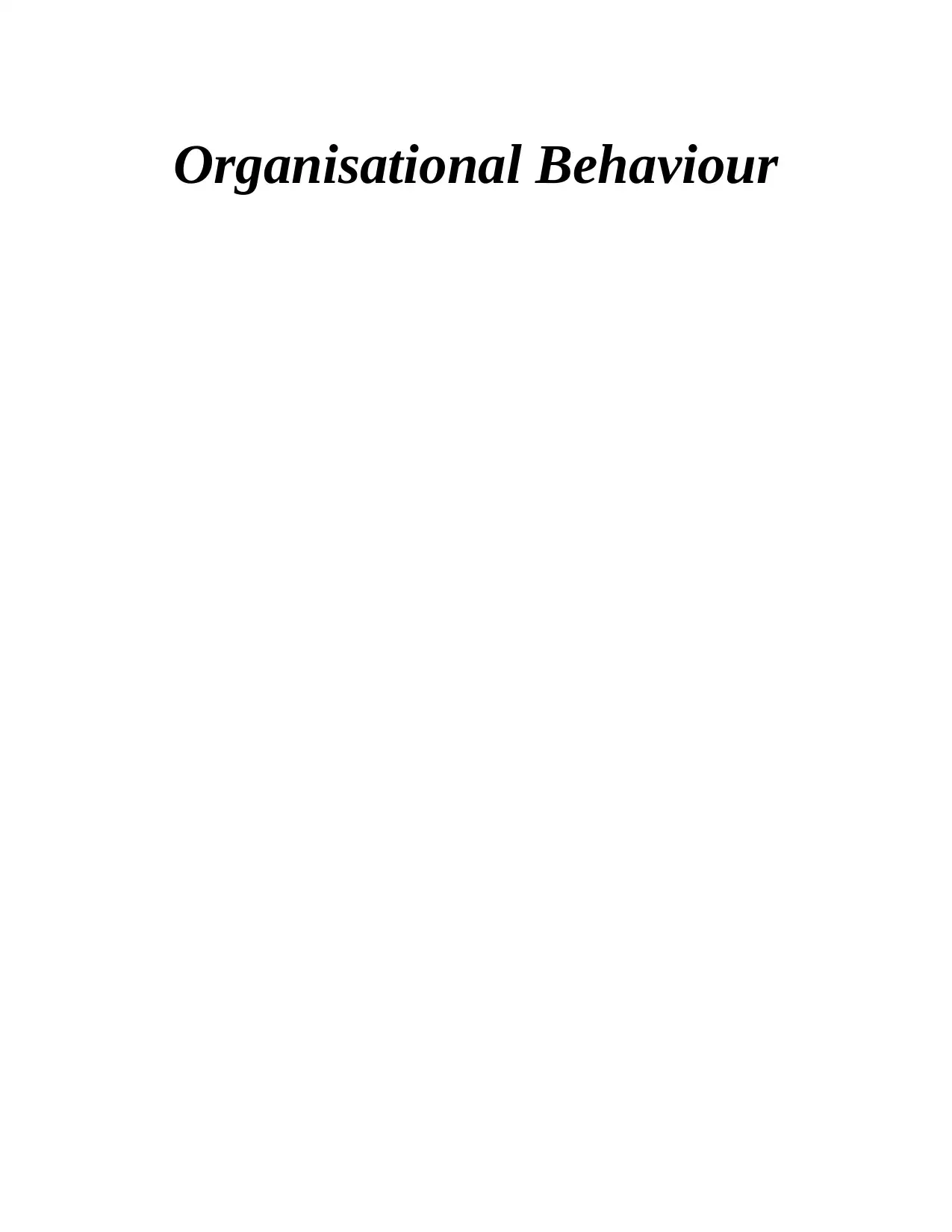
Organisational Behaviour
Paraphrase This Document
Need a fresh take? Get an instant paraphrase of this document with our AI Paraphraser
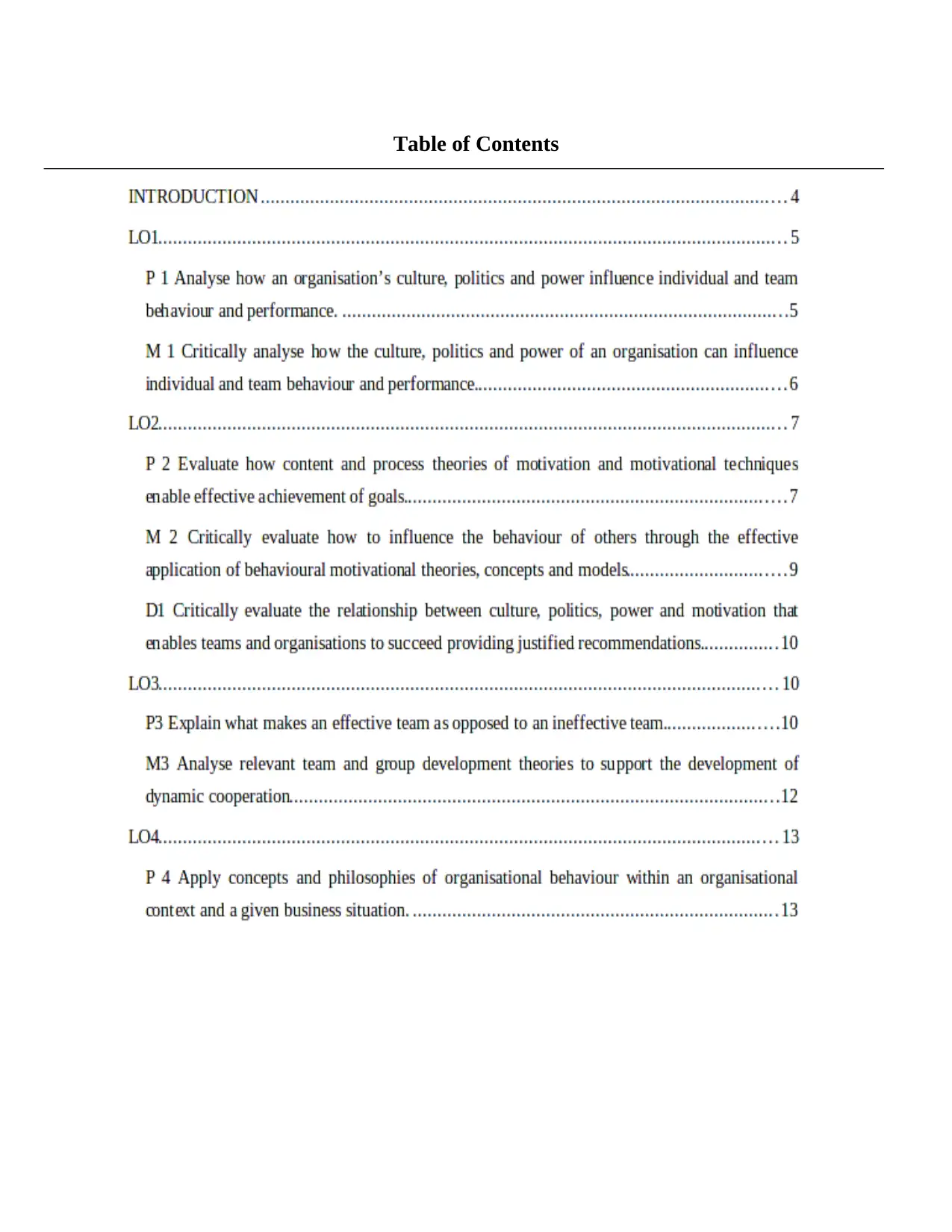
Table of Contents
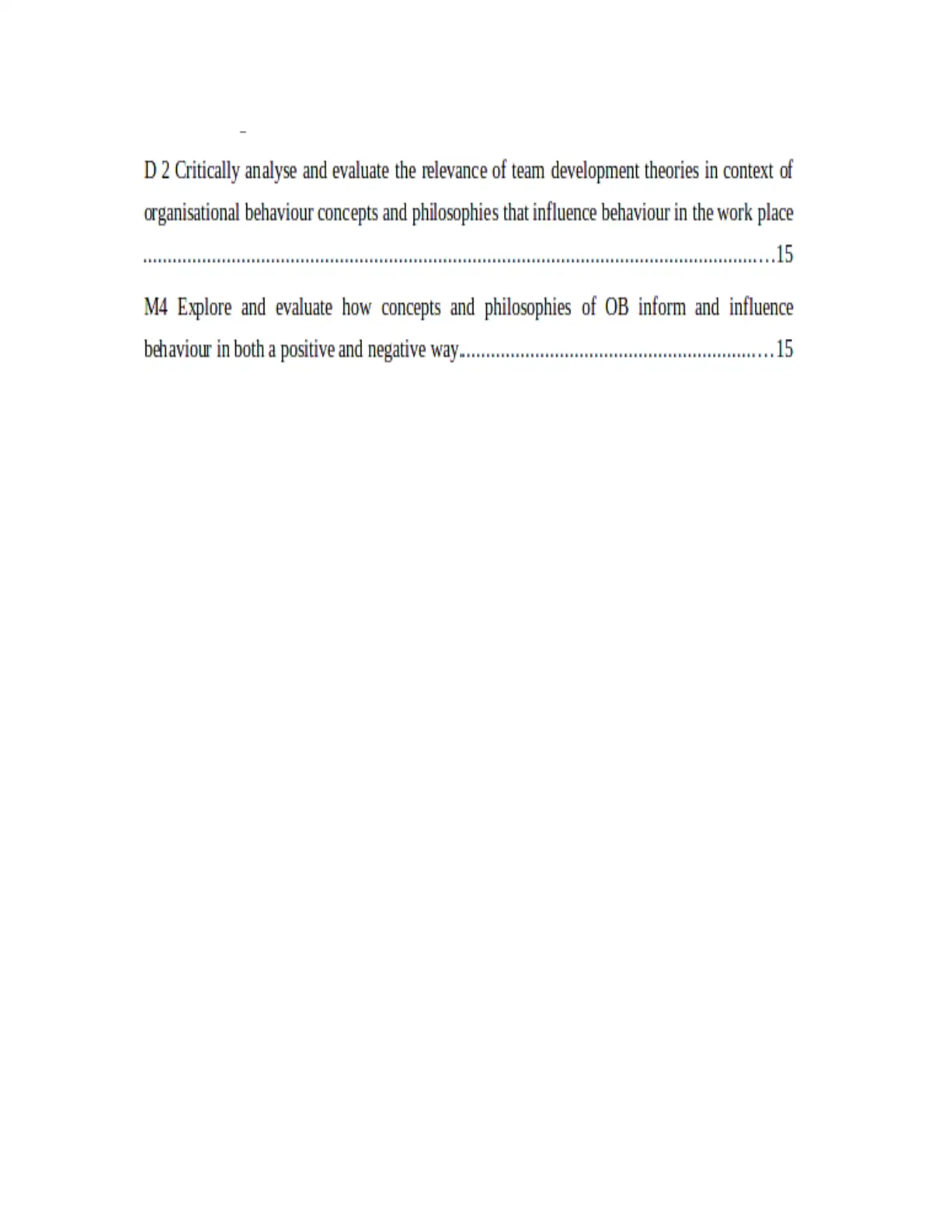
⊘ This is a preview!⊘
Do you want full access?
Subscribe today to unlock all pages.

Trusted by 1+ million students worldwide
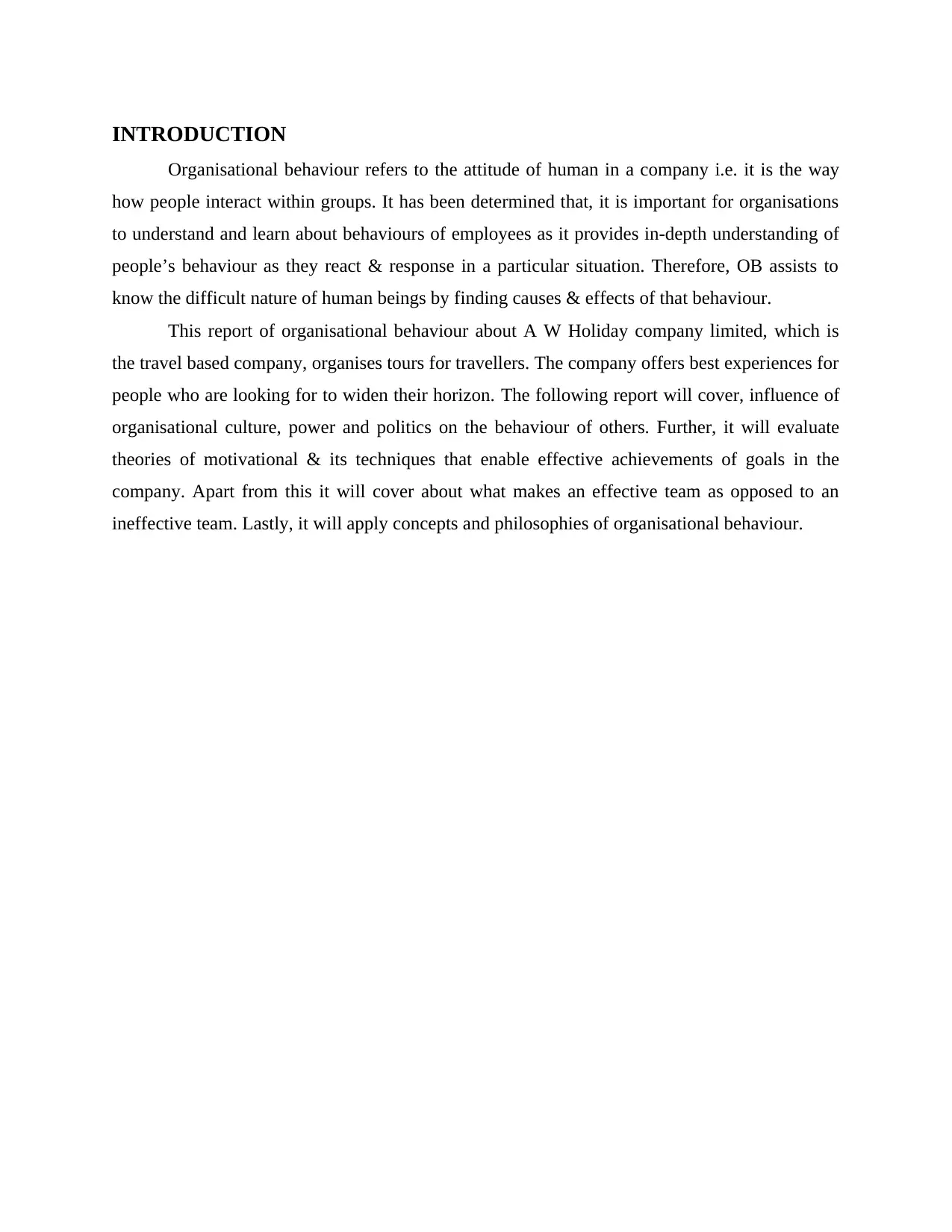
INTRODUCTION
Organisational behaviour refers to the attitude of human in a company i.e. it is the way
how people interact within groups. It has been determined that, it is important for organisations
to understand and learn about behaviours of employees as it provides in-depth understanding of
people’s behaviour as they react & response in a particular situation. Therefore, OB assists to
know the difficult nature of human beings by finding causes & effects of that behaviour.
This report of organisational behaviour about A W Holiday company limited, which is
the travel based company, organises tours for travellers. The company offers best experiences for
people who are looking for to widen their horizon. The following report will cover, influence of
organisational culture, power and politics on the behaviour of others. Further, it will evaluate
theories of motivational & its techniques that enable effective achievements of goals in the
company. Apart from this it will cover about what makes an effective team as opposed to an
ineffective team. Lastly, it will apply concepts and philosophies of organisational behaviour.
Organisational behaviour refers to the attitude of human in a company i.e. it is the way
how people interact within groups. It has been determined that, it is important for organisations
to understand and learn about behaviours of employees as it provides in-depth understanding of
people’s behaviour as they react & response in a particular situation. Therefore, OB assists to
know the difficult nature of human beings by finding causes & effects of that behaviour.
This report of organisational behaviour about A W Holiday company limited, which is
the travel based company, organises tours for travellers. The company offers best experiences for
people who are looking for to widen their horizon. The following report will cover, influence of
organisational culture, power and politics on the behaviour of others. Further, it will evaluate
theories of motivational & its techniques that enable effective achievements of goals in the
company. Apart from this it will cover about what makes an effective team as opposed to an
ineffective team. Lastly, it will apply concepts and philosophies of organisational behaviour.
Paraphrase This Document
Need a fresh take? Get an instant paraphrase of this document with our AI Paraphraser
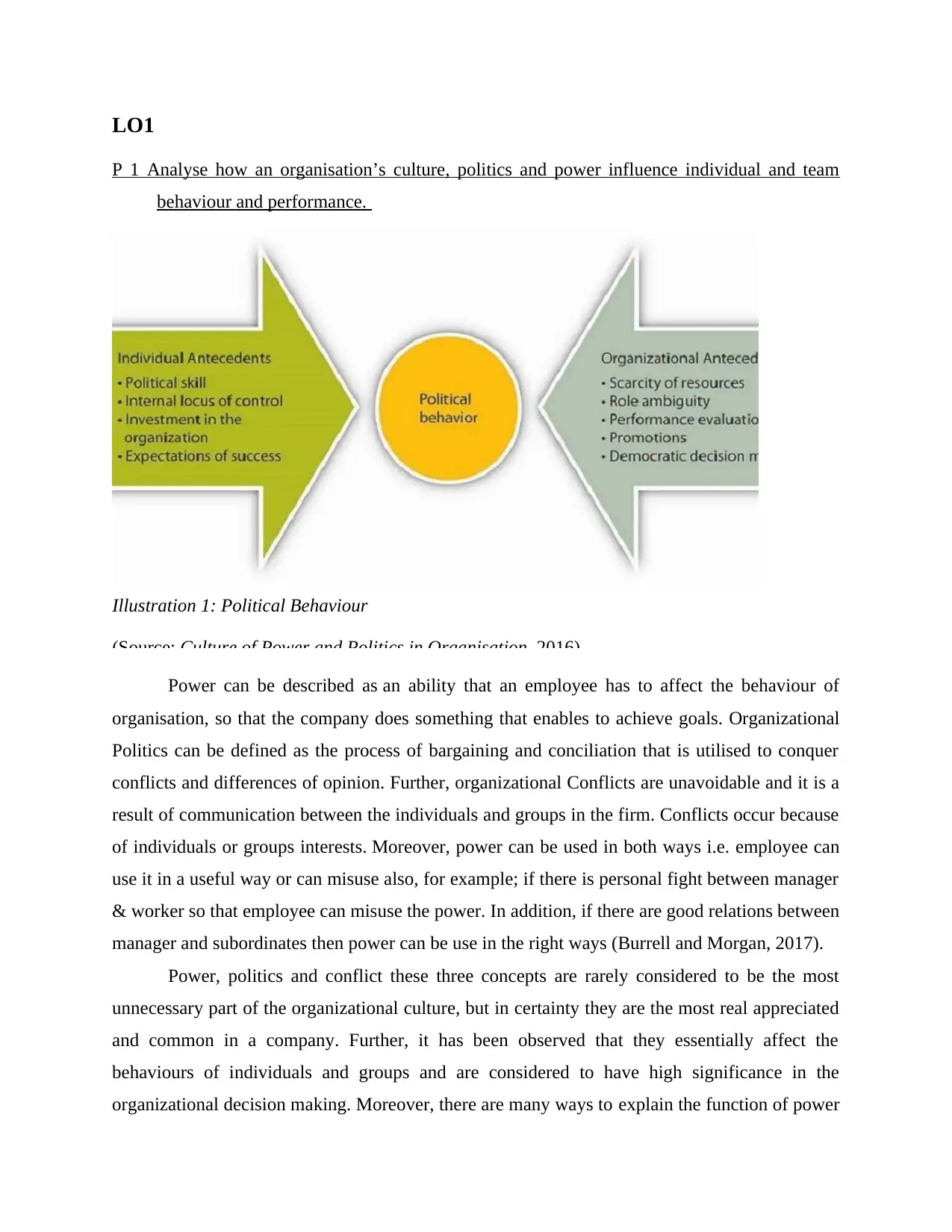
LO1
P 1 Analyse how an organisation’s culture, politics and power influence individual and team
behaviour and performance.
Illustration 1: Political Behaviour
(Source: Culture of Power and Politics in Organisation, 2016)
Power can be described as an ability that an employee has to affect the behaviour of
organisation, so that the company does something that enables to achieve goals. Organizational
Politics can be defined as the process of bargaining and conciliation that is utilised to conquer
conflicts and differences of opinion. Further, organizational Conflicts are unavoidable and it is a
result of communication between the individuals and groups in the firm. Conflicts occur because
of individuals or groups interests. Moreover, power can be used in both ways i.e. employee can
use it in a useful way or can misuse also, for example; if there is personal fight between manager
& worker so that employee can misuse the power. In addition, if there are good relations between
manager and subordinates then power can be use in the right ways (Burrell and Morgan, 2017).
Power, politics and conflict these three concepts are rarely considered to be the most
unnecessary part of the organizational culture, but in certainty they are the most real appreciated
and common in a company. Further, it has been observed that they essentially affect the
behaviours of individuals and groups and are considered to have high significance in the
organizational decision making. Moreover, there are many ways to explain the function of power
P 1 Analyse how an organisation’s culture, politics and power influence individual and team
behaviour and performance.
Illustration 1: Political Behaviour
(Source: Culture of Power and Politics in Organisation, 2016)
Power can be described as an ability that an employee has to affect the behaviour of
organisation, so that the company does something that enables to achieve goals. Organizational
Politics can be defined as the process of bargaining and conciliation that is utilised to conquer
conflicts and differences of opinion. Further, organizational Conflicts are unavoidable and it is a
result of communication between the individuals and groups in the firm. Conflicts occur because
of individuals or groups interests. Moreover, power can be used in both ways i.e. employee can
use it in a useful way or can misuse also, for example; if there is personal fight between manager
& worker so that employee can misuse the power. In addition, if there are good relations between
manager and subordinates then power can be use in the right ways (Burrell and Morgan, 2017).
Power, politics and conflict these three concepts are rarely considered to be the most
unnecessary part of the organizational culture, but in certainty they are the most real appreciated
and common in a company. Further, it has been observed that they essentially affect the
behaviours of individuals and groups and are considered to have high significance in the
organizational decision making. Moreover, there are many ways to explain the function of power
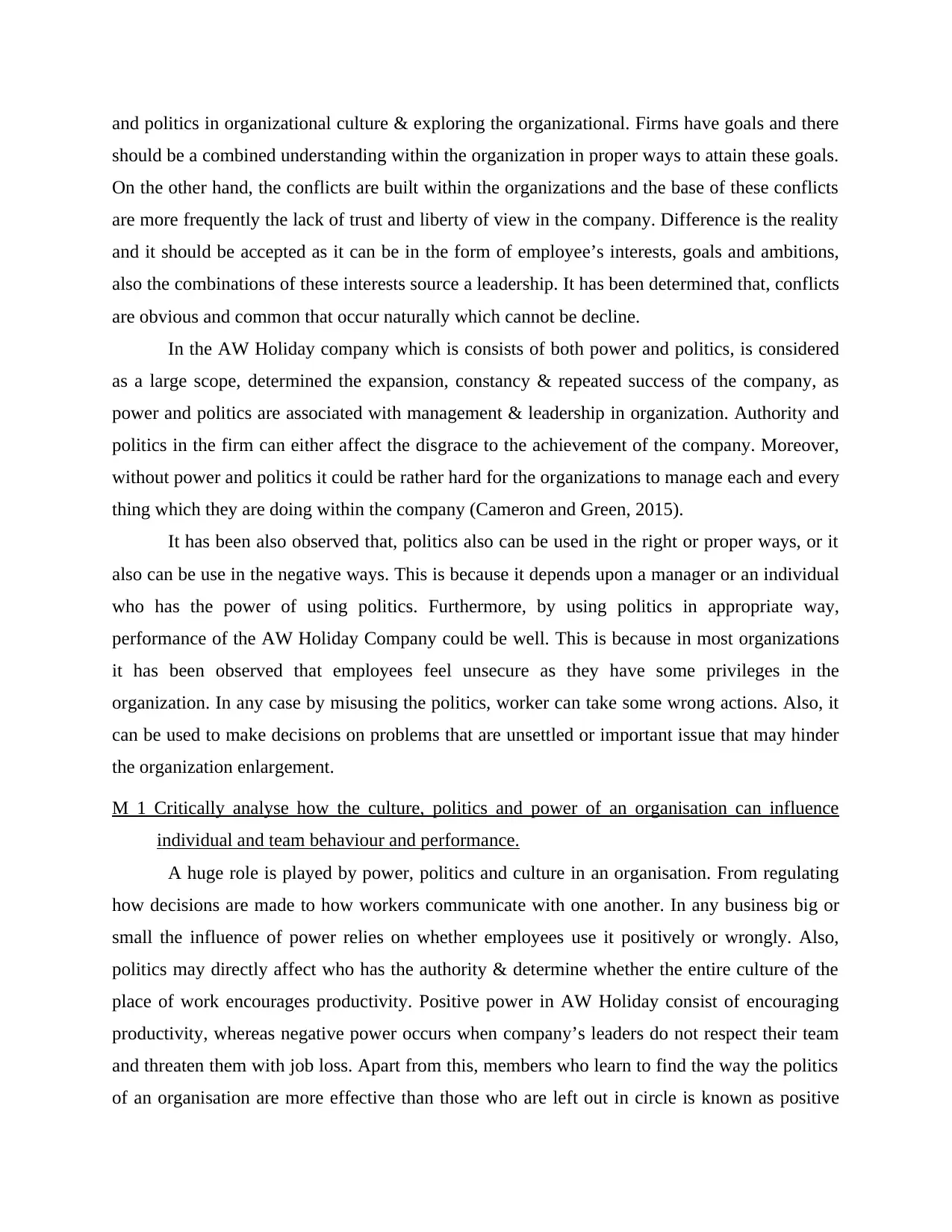
and politics in organizational culture & exploring the organizational. Firms have goals and there
should be a combined understanding within the organization in proper ways to attain these goals.
On the other hand, the conflicts are built within the organizations and the base of these conflicts
are more frequently the lack of trust and liberty of view in the company. Difference is the reality
and it should be accepted as it can be in the form of employee’s interests, goals and ambitions,
also the combinations of these interests source a leadership. It has been determined that, conflicts
are obvious and common that occur naturally which cannot be decline.
In the AW Holiday company which is consists of both power and politics, is considered
as a large scope, determined the expansion, constancy & repeated success of the company, as
power and politics are associated with management & leadership in organization. Authority and
politics in the firm can either affect the disgrace to the achievement of the company. Moreover,
without power and politics it could be rather hard for the organizations to manage each and every
thing which they are doing within the company (Cameron and Green, 2015).
It has been also observed that, politics also can be used in the right or proper ways, or it
also can be use in the negative ways. This is because it depends upon a manager or an individual
who has the power of using politics. Furthermore, by using politics in appropriate way,
performance of the AW Holiday Company could be well. This is because in most organizations
it has been observed that employees feel unsecure as they have some privileges in the
organization. In any case by misusing the politics, worker can take some wrong actions. Also, it
can be used to make decisions on problems that are unsettled or important issue that may hinder
the organization enlargement.
M 1 Critically analyse how the culture, politics and power of an organisation can influence
individual and team behaviour and performance.
A huge role is played by power, politics and culture in an organisation. From regulating
how decisions are made to how workers communicate with one another. In any business big or
small the influence of power relies on whether employees use it positively or wrongly. Also,
politics may directly affect who has the authority & determine whether the entire culture of the
place of work encourages productivity. Positive power in AW Holiday consist of encouraging
productivity, whereas negative power occurs when company’s leaders do not respect their team
and threaten them with job loss. Apart from this, members who learn to find the way the politics
of an organisation are more effective than those who are left out in circle is known as positive
should be a combined understanding within the organization in proper ways to attain these goals.
On the other hand, the conflicts are built within the organizations and the base of these conflicts
are more frequently the lack of trust and liberty of view in the company. Difference is the reality
and it should be accepted as it can be in the form of employee’s interests, goals and ambitions,
also the combinations of these interests source a leadership. It has been determined that, conflicts
are obvious and common that occur naturally which cannot be decline.
In the AW Holiday company which is consists of both power and politics, is considered
as a large scope, determined the expansion, constancy & repeated success of the company, as
power and politics are associated with management & leadership in organization. Authority and
politics in the firm can either affect the disgrace to the achievement of the company. Moreover,
without power and politics it could be rather hard for the organizations to manage each and every
thing which they are doing within the company (Cameron and Green, 2015).
It has been also observed that, politics also can be used in the right or proper ways, or it
also can be use in the negative ways. This is because it depends upon a manager or an individual
who has the power of using politics. Furthermore, by using politics in appropriate way,
performance of the AW Holiday Company could be well. This is because in most organizations
it has been observed that employees feel unsecure as they have some privileges in the
organization. In any case by misusing the politics, worker can take some wrong actions. Also, it
can be used to make decisions on problems that are unsettled or important issue that may hinder
the organization enlargement.
M 1 Critically analyse how the culture, politics and power of an organisation can influence
individual and team behaviour and performance.
A huge role is played by power, politics and culture in an organisation. From regulating
how decisions are made to how workers communicate with one another. In any business big or
small the influence of power relies on whether employees use it positively or wrongly. Also,
politics may directly affect who has the authority & determine whether the entire culture of the
place of work encourages productivity. Positive power in AW Holiday consist of encouraging
productivity, whereas negative power occurs when company’s leaders do not respect their team
and threaten them with job loss. Apart from this, members who learn to find the way the politics
of an organisation are more effective than those who are left out in circle is known as positive
⊘ This is a preview!⊘
Do you want full access?
Subscribe today to unlock all pages.

Trusted by 1+ million students worldwide
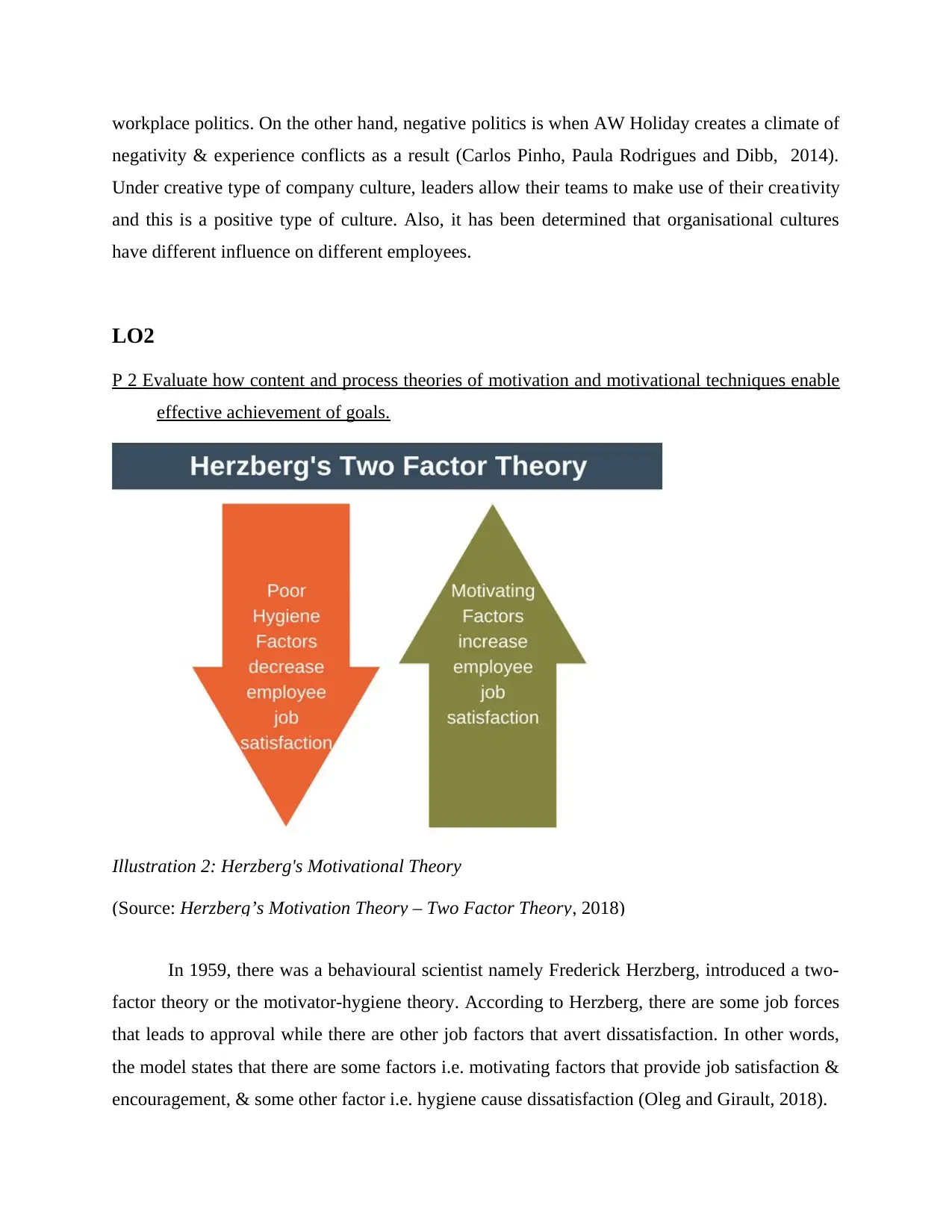
workplace politics. On the other hand, negative politics is when AW Holiday creates a climate of
negativity & experience conflicts as a result (Carlos Pinho, Paula Rodrigues and Dibb, 2014).
Under creative type of company culture, leaders allow their teams to make use of their creativity
and this is a positive type of culture. Also, it has been determined that organisational cultures
have different influence on different employees.
LO2
P 2 Evaluate how content and process theories of motivation and motivational techniques enable
effective achievement of goals.
Illustration 2: Herzberg's Motivational Theory
(Source: Herzberg’s Motivation Theory – Two Factor Theory, 2018)
In 1959, there was a behavioural scientist namely Frederick Herzberg, introduced a two-
factor theory or the motivator-hygiene theory. According to Herzberg, there are some job forces
that leads to approval while there are other job factors that avert dissatisfaction. In other words,
the model states that there are some factors i.e. motivating factors that provide job satisfaction &
encouragement, & some other factor i.e. hygiene cause dissatisfaction (Oleg and Girault, 2018).
negativity & experience conflicts as a result (Carlos Pinho, Paula Rodrigues and Dibb, 2014).
Under creative type of company culture, leaders allow their teams to make use of their creativity
and this is a positive type of culture. Also, it has been determined that organisational cultures
have different influence on different employees.
LO2
P 2 Evaluate how content and process theories of motivation and motivational techniques enable
effective achievement of goals.
Illustration 2: Herzberg's Motivational Theory
(Source: Herzberg’s Motivation Theory – Two Factor Theory, 2018)
In 1959, there was a behavioural scientist namely Frederick Herzberg, introduced a two-
factor theory or the motivator-hygiene theory. According to Herzberg, there are some job forces
that leads to approval while there are other job factors that avert dissatisfaction. In other words,
the model states that there are some factors i.e. motivating factors that provide job satisfaction &
encouragement, & some other factor i.e. hygiene cause dissatisfaction (Oleg and Girault, 2018).
Paraphrase This Document
Need a fresh take? Get an instant paraphrase of this document with our AI Paraphraser
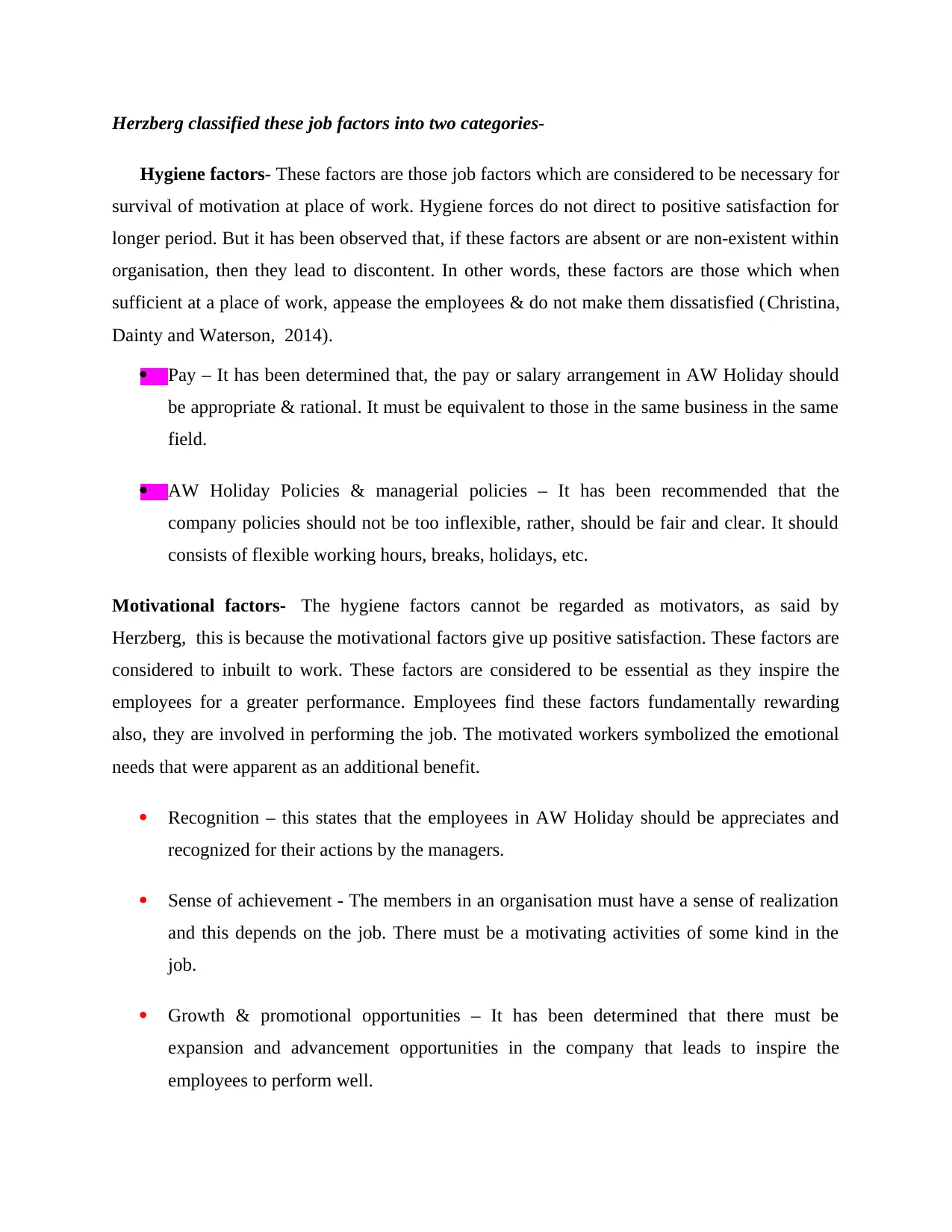
Herzberg classified these job factors into two categories-
Hygiene factors- These factors are those job factors which are considered to be necessary for
survival of motivation at place of work. Hygiene forces do not direct to positive satisfaction for
longer period. But it has been observed that, if these factors are absent or are non-existent within
organisation, then they lead to discontent. In other words, these factors are those which when
sufficient at a place of work, appease the employees & do not make them dissatisfied (Christina,
Dainty and Waterson, 2014).
Pay – It has been determined that, the pay or salary arrangement in AW Holiday should
be appropriate & rational. It must be equivalent to those in the same business in the same
field.
AW Holiday Policies & managerial policies – It has been recommended that the
company policies should not be too inflexible, rather, should be fair and clear. It should
consists of flexible working hours, breaks, holidays, etc.
Motivational factors- The hygiene factors cannot be regarded as motivators, as said by
Herzberg, this is because the motivational factors give up positive satisfaction. These factors are
considered to inbuilt to work. These factors are considered to be essential as they inspire the
employees for a greater performance. Employees find these factors fundamentally rewarding
also, they are involved in performing the job. The motivated workers symbolized the emotional
needs that were apparent as an additional benefit.
Recognition – this states that the employees in AW Holiday should be appreciates and
recognized for their actions by the managers.
Sense of achievement - The members in an organisation must have a sense of realization
and this depends on the job. There must be a motivating activities of some kind in the
job.
Growth & promotional opportunities – It has been determined that there must be
expansion and advancement opportunities in the company that leads to inspire the
employees to perform well.
Hygiene factors- These factors are those job factors which are considered to be necessary for
survival of motivation at place of work. Hygiene forces do not direct to positive satisfaction for
longer period. But it has been observed that, if these factors are absent or are non-existent within
organisation, then they lead to discontent. In other words, these factors are those which when
sufficient at a place of work, appease the employees & do not make them dissatisfied (Christina,
Dainty and Waterson, 2014).
Pay – It has been determined that, the pay or salary arrangement in AW Holiday should
be appropriate & rational. It must be equivalent to those in the same business in the same
field.
AW Holiday Policies & managerial policies – It has been recommended that the
company policies should not be too inflexible, rather, should be fair and clear. It should
consists of flexible working hours, breaks, holidays, etc.
Motivational factors- The hygiene factors cannot be regarded as motivators, as said by
Herzberg, this is because the motivational factors give up positive satisfaction. These factors are
considered to inbuilt to work. These factors are considered to be essential as they inspire the
employees for a greater performance. Employees find these factors fundamentally rewarding
also, they are involved in performing the job. The motivated workers symbolized the emotional
needs that were apparent as an additional benefit.
Recognition – this states that the employees in AW Holiday should be appreciates and
recognized for their actions by the managers.
Sense of achievement - The members in an organisation must have a sense of realization
and this depends on the job. There must be a motivating activities of some kind in the
job.
Growth & promotional opportunities – It has been determined that there must be
expansion and advancement opportunities in the company that leads to inspire the
employees to perform well.
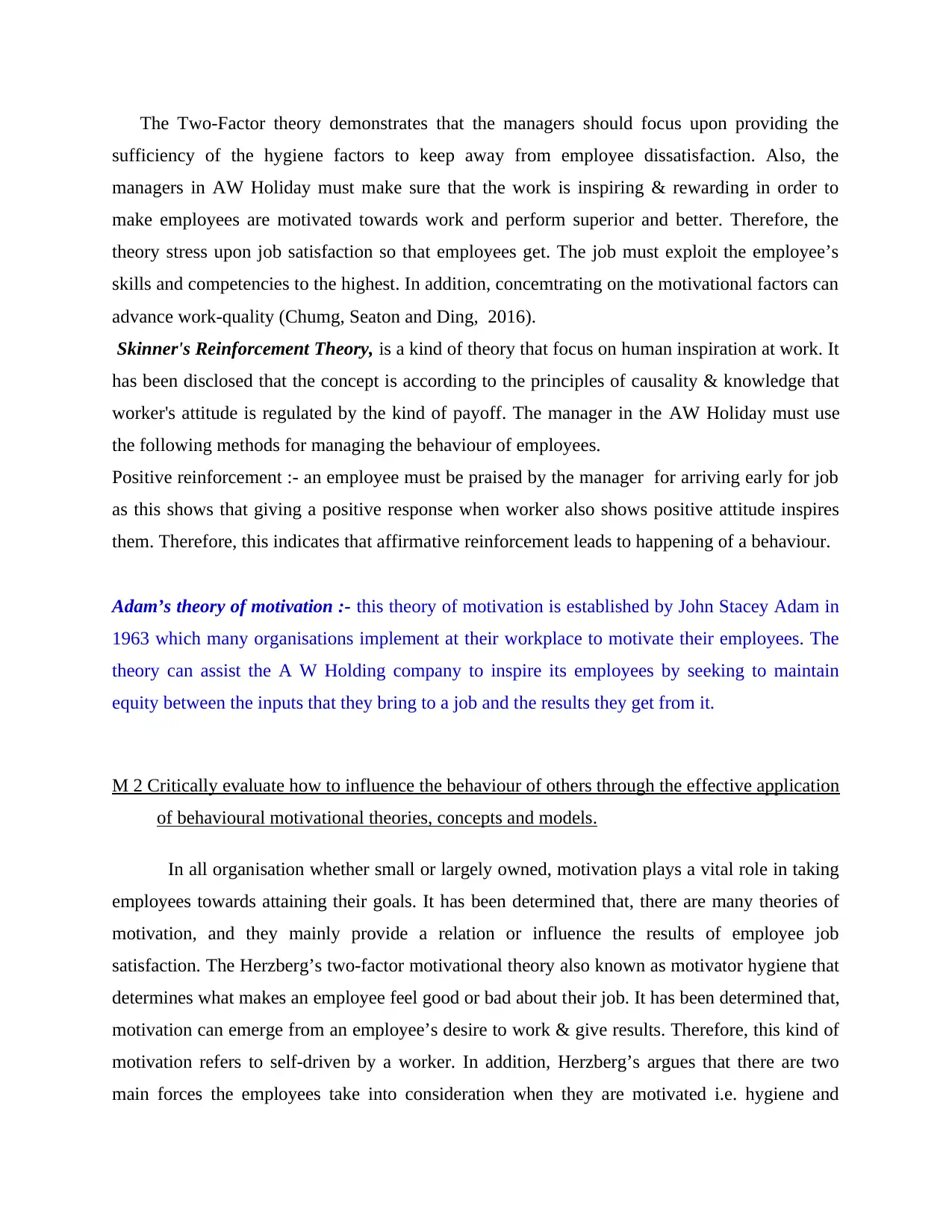
The Two-Factor theory demonstrates that the managers should focus upon providing the
sufficiency of the hygiene factors to keep away from employee dissatisfaction. Also, the
managers in AW Holiday must make sure that the work is inspiring & rewarding in order to
make employees are motivated towards work and perform superior and better. Therefore, the
theory stress upon job satisfaction so that employees get. The job must exploit the employee’s
skills and competencies to the highest. In addition, concemtrating on the motivational factors can
advance work-quality (Chumg, Seaton and Ding, 2016).
Skinner's Reinforcement Theory, is a kind of theory that focus on human inspiration at work. It
has been disclosed that the concept is according to the principles of causality & knowledge that
worker's attitude is regulated by the kind of payoff. The manager in the AW Holiday must use
the following methods for managing the behaviour of employees.
Positive reinforcement :- an employee must be praised by the manager for arriving early for job
as this shows that giving a positive response when worker also shows positive attitude inspires
them. Therefore, this indicates that affirmative reinforcement leads to happening of a behaviour.
Adam’s theory of motivation :- this theory of motivation is established by John Stacey Adam in
1963 which many organisations implement at their workplace to motivate their employees. The
theory can assist the A W Holding company to inspire its employees by seeking to maintain
equity between the inputs that they bring to a job and the results they get from it.
M 2 Critically evaluate how to influence the behaviour of others through the effective application
of behavioural motivational theories, concepts and models.
In all organisation whether small or largely owned, motivation plays a vital role in taking
employees towards attaining their goals. It has been determined that, there are many theories of
motivation, and they mainly provide a relation or influence the results of employee job
satisfaction. The Herzberg’s two-factor motivational theory also known as motivator hygiene that
determines what makes an employee feel good or bad about their job. It has been determined that,
motivation can emerge from an employee’s desire to work & give results. Therefore, this kind of
motivation refers to self-driven by a worker. In addition, Herzberg’s argues that there are two
main forces the employees take into consideration when they are motivated i.e. hygiene and
sufficiency of the hygiene factors to keep away from employee dissatisfaction. Also, the
managers in AW Holiday must make sure that the work is inspiring & rewarding in order to
make employees are motivated towards work and perform superior and better. Therefore, the
theory stress upon job satisfaction so that employees get. The job must exploit the employee’s
skills and competencies to the highest. In addition, concemtrating on the motivational factors can
advance work-quality (Chumg, Seaton and Ding, 2016).
Skinner's Reinforcement Theory, is a kind of theory that focus on human inspiration at work. It
has been disclosed that the concept is according to the principles of causality & knowledge that
worker's attitude is regulated by the kind of payoff. The manager in the AW Holiday must use
the following methods for managing the behaviour of employees.
Positive reinforcement :- an employee must be praised by the manager for arriving early for job
as this shows that giving a positive response when worker also shows positive attitude inspires
them. Therefore, this indicates that affirmative reinforcement leads to happening of a behaviour.
Adam’s theory of motivation :- this theory of motivation is established by John Stacey Adam in
1963 which many organisations implement at their workplace to motivate their employees. The
theory can assist the A W Holding company to inspire its employees by seeking to maintain
equity between the inputs that they bring to a job and the results they get from it.
M 2 Critically evaluate how to influence the behaviour of others through the effective application
of behavioural motivational theories, concepts and models.
In all organisation whether small or largely owned, motivation plays a vital role in taking
employees towards attaining their goals. It has been determined that, there are many theories of
motivation, and they mainly provide a relation or influence the results of employee job
satisfaction. The Herzberg’s two-factor motivational theory also known as motivator hygiene that
determines what makes an employee feel good or bad about their job. It has been determined that,
motivation can emerge from an employee’s desire to work & give results. Therefore, this kind of
motivation refers to self-driven by a worker. In addition, Herzberg’s argues that there are two
main forces the employees take into consideration when they are motivated i.e. hygiene and
⊘ This is a preview!⊘
Do you want full access?
Subscribe today to unlock all pages.

Trusted by 1+ million students worldwide
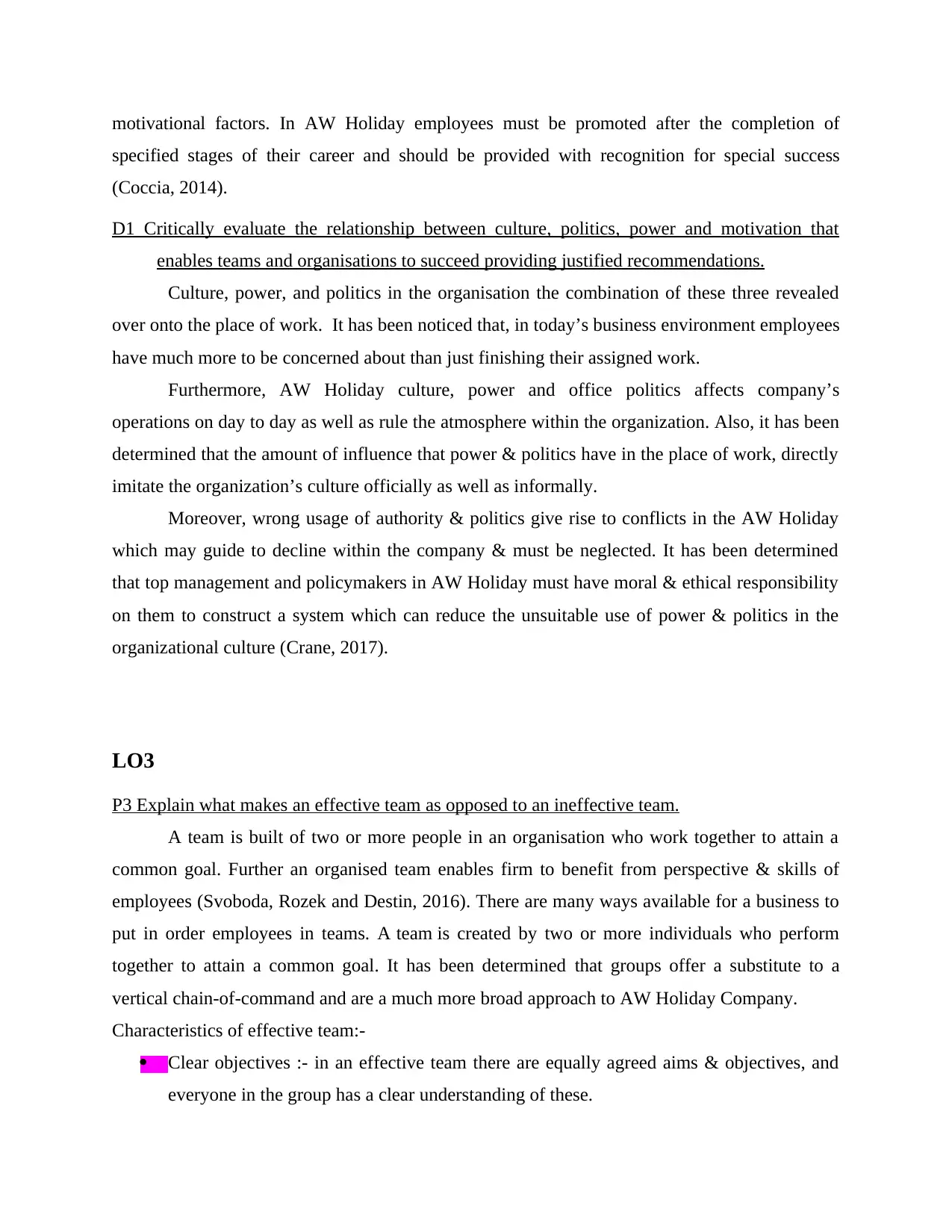
motivational factors. In AW Holiday employees must be promoted after the completion of
specified stages of their career and should be provided with recognition for special success
(Coccia, 2014).
D1 Critically evaluate the relationship between culture, politics, power and motivation that
enables teams and organisations to succeed providing justified recommendations.
Culture, power, and politics in the organisation the combination of these three revealed
over onto the place of work. It has been noticed that, in today’s business environment employees
have much more to be concerned about than just finishing their assigned work.
Furthermore, AW Holiday culture, power and office politics affects company’s
operations on day to day as well as rule the atmosphere within the organization. Also, it has been
determined that the amount of influence that power & politics have in the place of work, directly
imitate the organization’s culture officially as well as informally.
Moreover, wrong usage of authority & politics give rise to conflicts in the AW Holiday
which may guide to decline within the company & must be neglected. It has been determined
that top management and policymakers in AW Holiday must have moral & ethical responsibility
on them to construct a system which can reduce the unsuitable use of power & politics in the
organizational culture (Crane, 2017).
LO3
P3 Explain what makes an effective team as opposed to an ineffective team.
A team is built of two or more people in an organisation who work together to attain a
common goal. Further an organised team enables firm to benefit from perspective & skills of
employees (Svoboda, Rozek and Destin, 2016). There are many ways available for a business to
put in order employees in teams. A team is created by two or more individuals who perform
together to attain a common goal. It has been determined that groups offer a substitute to a
vertical chain-of-command and are a much more broad approach to AW Holiday Company.
Characteristics of effective team:-
Clear objectives :- in an effective team there are equally agreed aims & objectives, and
everyone in the group has a clear understanding of these.
specified stages of their career and should be provided with recognition for special success
(Coccia, 2014).
D1 Critically evaluate the relationship between culture, politics, power and motivation that
enables teams and organisations to succeed providing justified recommendations.
Culture, power, and politics in the organisation the combination of these three revealed
over onto the place of work. It has been noticed that, in today’s business environment employees
have much more to be concerned about than just finishing their assigned work.
Furthermore, AW Holiday culture, power and office politics affects company’s
operations on day to day as well as rule the atmosphere within the organization. Also, it has been
determined that the amount of influence that power & politics have in the place of work, directly
imitate the organization’s culture officially as well as informally.
Moreover, wrong usage of authority & politics give rise to conflicts in the AW Holiday
which may guide to decline within the company & must be neglected. It has been determined
that top management and policymakers in AW Holiday must have moral & ethical responsibility
on them to construct a system which can reduce the unsuitable use of power & politics in the
organizational culture (Crane, 2017).
LO3
P3 Explain what makes an effective team as opposed to an ineffective team.
A team is built of two or more people in an organisation who work together to attain a
common goal. Further an organised team enables firm to benefit from perspective & skills of
employees (Svoboda, Rozek and Destin, 2016). There are many ways available for a business to
put in order employees in teams. A team is created by two or more individuals who perform
together to attain a common goal. It has been determined that groups offer a substitute to a
vertical chain-of-command and are a much more broad approach to AW Holiday Company.
Characteristics of effective team:-
Clear objectives :- in an effective team there are equally agreed aims & objectives, and
everyone in the group has a clear understanding of these.
Paraphrase This Document
Need a fresh take? Get an instant paraphrase of this document with our AI Paraphraser
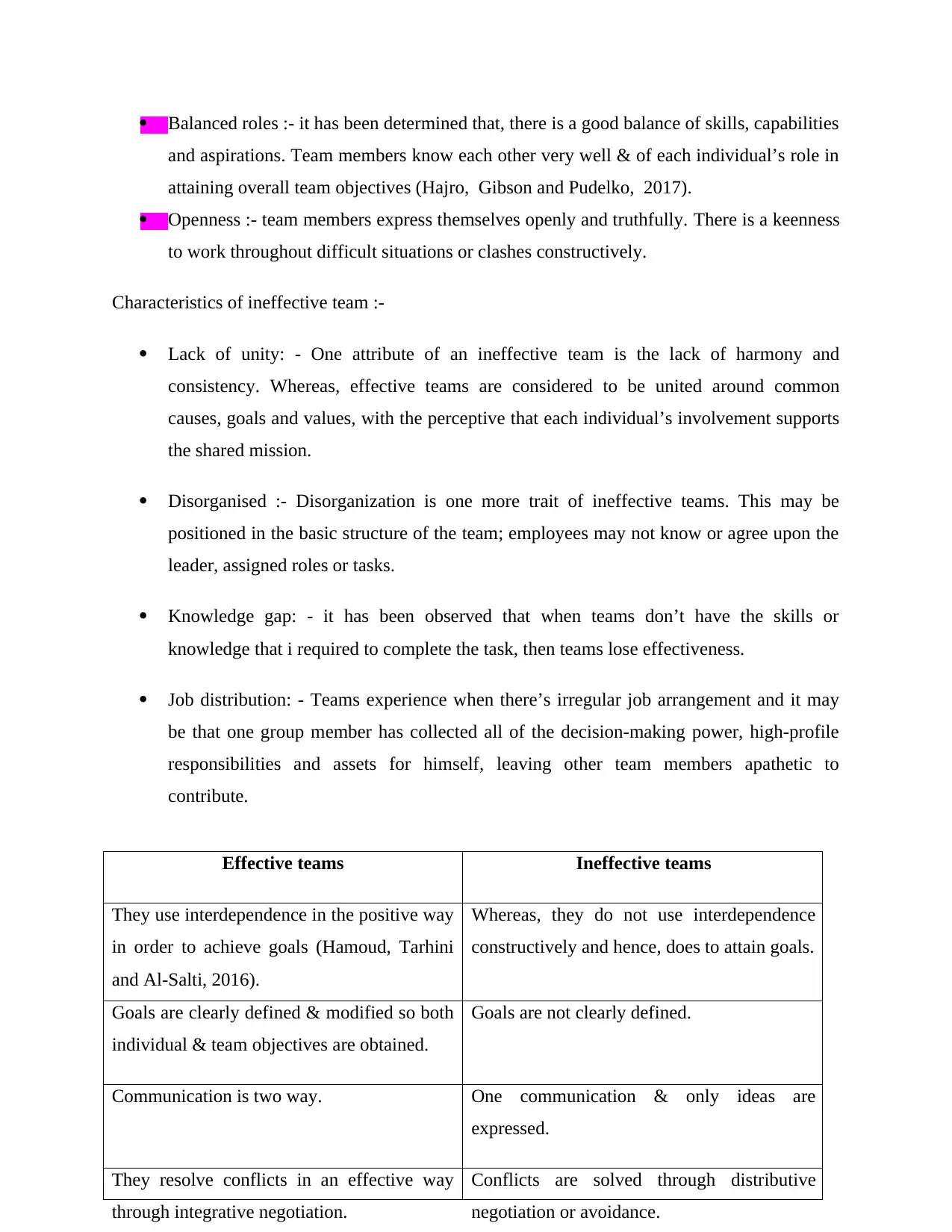
Balanced roles :- it has been determined that, there is a good balance of skills, capabilities
and aspirations. Team members know each other very well & of each individual’s role in
attaining overall team objectives (Hajro, Gibson and Pudelko, 2017).
Openness :- team members express themselves openly and truthfully. There is a keenness
to work throughout difficult situations or clashes constructively.
Characteristics of ineffective team :-
Lack of unity: - One attribute of an ineffective team is the lack of harmony and
consistency. Whereas, effective teams are considered to be united around common
causes, goals and values, with the perceptive that each individual’s involvement supports
the shared mission.
Disorganised :- Disorganization is one more trait of ineffective teams. This may be
positioned in the basic structure of the team; employees may not know or agree upon the
leader, assigned roles or tasks.
Knowledge gap: - it has been observed that when teams don’t have the skills or
knowledge that i required to complete the task, then teams lose effectiveness.
Job distribution: - Teams experience when there’s irregular job arrangement and it may
be that one group member has collected all of the decision-making power, high-profile
responsibilities and assets for himself, leaving other team members apathetic to
contribute.
Effective teams Ineffective teams
They use interdependence in the positive way
in order to achieve goals (Hamoud, Tarhini
and Al-Salti, 2016).
Whereas, they do not use interdependence
constructively and hence, does to attain goals.
Goals are clearly defined & modified so both
individual & team objectives are obtained.
Goals are not clearly defined.
Communication is two way. One communication & only ideas are
expressed.
They resolve conflicts in an effective way
through integrative negotiation.
Conflicts are solved through distributive
negotiation or avoidance.
and aspirations. Team members know each other very well & of each individual’s role in
attaining overall team objectives (Hajro, Gibson and Pudelko, 2017).
Openness :- team members express themselves openly and truthfully. There is a keenness
to work throughout difficult situations or clashes constructively.
Characteristics of ineffective team :-
Lack of unity: - One attribute of an ineffective team is the lack of harmony and
consistency. Whereas, effective teams are considered to be united around common
causes, goals and values, with the perceptive that each individual’s involvement supports
the shared mission.
Disorganised :- Disorganization is one more trait of ineffective teams. This may be
positioned in the basic structure of the team; employees may not know or agree upon the
leader, assigned roles or tasks.
Knowledge gap: - it has been observed that when teams don’t have the skills or
knowledge that i required to complete the task, then teams lose effectiveness.
Job distribution: - Teams experience when there’s irregular job arrangement and it may
be that one group member has collected all of the decision-making power, high-profile
responsibilities and assets for himself, leaving other team members apathetic to
contribute.
Effective teams Ineffective teams
They use interdependence in the positive way
in order to achieve goals (Hamoud, Tarhini
and Al-Salti, 2016).
Whereas, they do not use interdependence
constructively and hence, does to attain goals.
Goals are clearly defined & modified so both
individual & team objectives are obtained.
Goals are not clearly defined.
Communication is two way. One communication & only ideas are
expressed.
They resolve conflicts in an effective way
through integrative negotiation.
Conflicts are solved through distributive
negotiation or avoidance.
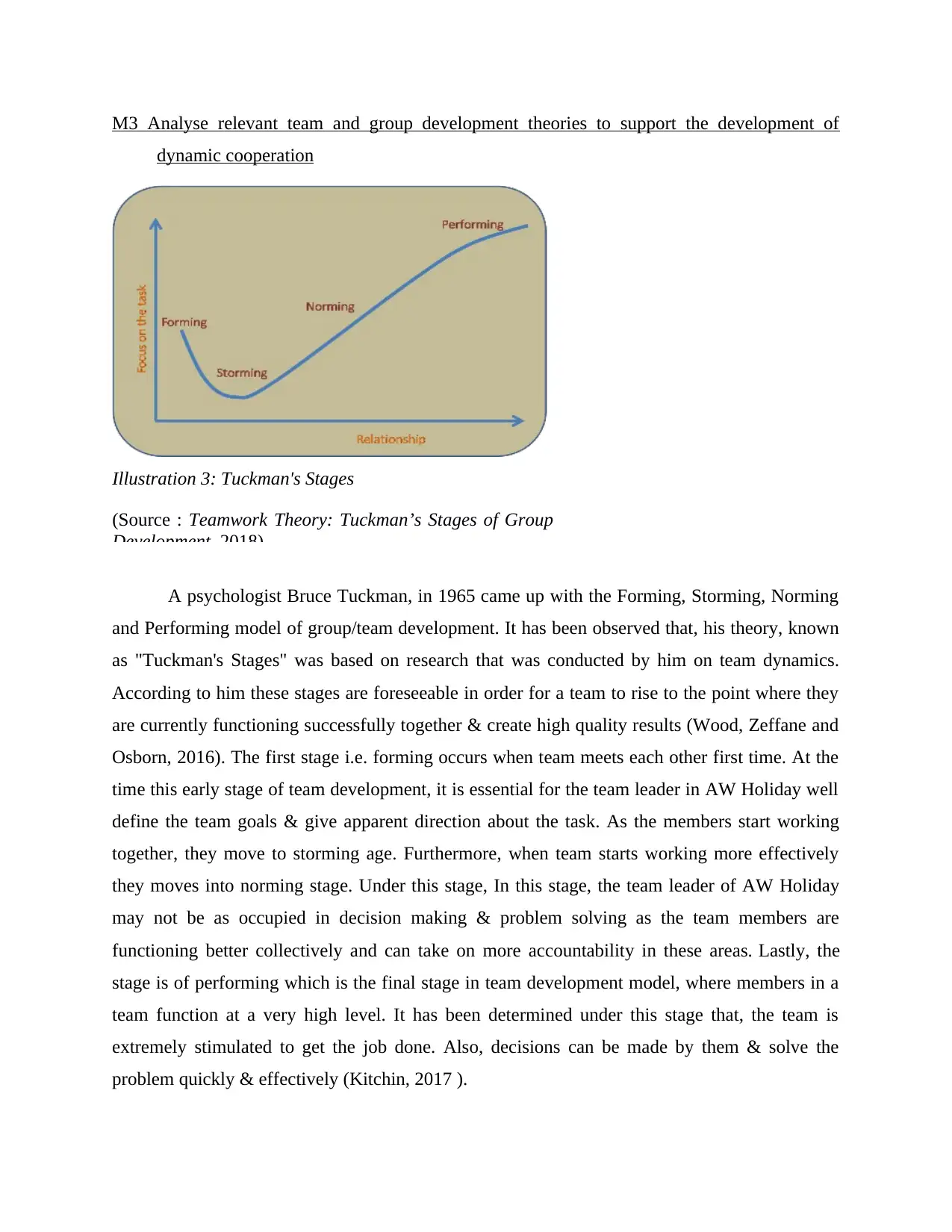
M3 Analyse relevant team and group development theories to support the development of
dynamic cooperation
Illustration 3: Tuckman's Stages
(Source : Teamwork Theory: Tuckman’s Stages of Group
Development, 2018)
A psychologist Bruce Tuckman, in 1965 came up with the Forming, Storming, Norming
and Performing model of group/team development. It has been observed that, his theory, known
as "Tuckman's Stages" was based on research that was conducted by him on team dynamics.
According to him these stages are foreseeable in order for a team to rise to the point where they
are currently functioning successfully together & create high quality results (Wood, Zeffane and
Osborn, 2016). The first stage i.e. forming occurs when team meets each other first time. At the
time this early stage of team development, it is essential for the team leader in AW Holiday well
define the team goals & give apparent direction about the task. As the members start working
together, they move to storming age. Furthermore, when team starts working more effectively
they moves into norming stage. Under this stage, In this stage, the team leader of AW Holiday
may not be as occupied in decision making & problem solving as the team members are
functioning better collectively and can take on more accountability in these areas. Lastly, the
stage is of performing which is the final stage in team development model, where members in a
team function at a very high level. It has been determined under this stage that, the team is
extremely stimulated to get the job done. Also, decisions can be made by them & solve the
problem quickly & effectively (Kitchin, 2017 ).
dynamic cooperation
Illustration 3: Tuckman's Stages
(Source : Teamwork Theory: Tuckman’s Stages of Group
Development, 2018)
A psychologist Bruce Tuckman, in 1965 came up with the Forming, Storming, Norming
and Performing model of group/team development. It has been observed that, his theory, known
as "Tuckman's Stages" was based on research that was conducted by him on team dynamics.
According to him these stages are foreseeable in order for a team to rise to the point where they
are currently functioning successfully together & create high quality results (Wood, Zeffane and
Osborn, 2016). The first stage i.e. forming occurs when team meets each other first time. At the
time this early stage of team development, it is essential for the team leader in AW Holiday well
define the team goals & give apparent direction about the task. As the members start working
together, they move to storming age. Furthermore, when team starts working more effectively
they moves into norming stage. Under this stage, In this stage, the team leader of AW Holiday
may not be as occupied in decision making & problem solving as the team members are
functioning better collectively and can take on more accountability in these areas. Lastly, the
stage is of performing which is the final stage in team development model, where members in a
team function at a very high level. It has been determined under this stage that, the team is
extremely stimulated to get the job done. Also, decisions can be made by them & solve the
problem quickly & effectively (Kitchin, 2017 ).
⊘ This is a preview!⊘
Do you want full access?
Subscribe today to unlock all pages.

Trusted by 1+ million students worldwide
1 out of 20
Related Documents
Your All-in-One AI-Powered Toolkit for Academic Success.
+13062052269
info@desklib.com
Available 24*7 on WhatsApp / Email
![[object Object]](/_next/static/media/star-bottom.7253800d.svg)
Unlock your academic potential
Copyright © 2020–2025 A2Z Services. All Rights Reserved. Developed and managed by ZUCOL.





